外研版七年级英语下册 Module 2 Unit 1优秀教案
- 格式:doc
- 大小:56.50 KB
- 文档页数:6
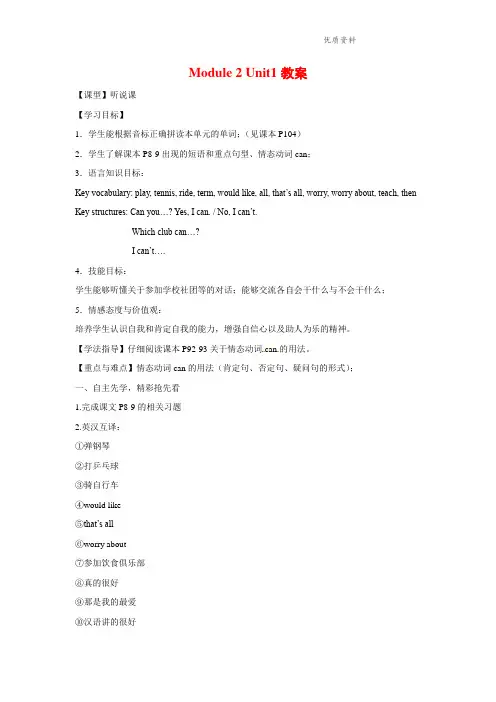
Module 2 Unit1教案【课型】听说课【学习目标】1.学生能根据音标正确拼读本单元的单词;(见课本P104)2.学生了解课本P8-9出现的短语和重点句型、情态动词can;3.语言知识目标:Key vocabulary: play, tennis, ride, term, would like, all, that’s all, worry, worry about, teach, then Key structures: Can you…? Yes, I can. / No, I can’t.Which club can…?I can’t….4.技能目标:学生能够听懂关于参加学校社团等的对话;能够交流各自会干什么与不会干什么;5.情感态度与价值观:培养学生认识自我和肯定自我的能力,增强自信心以及助人为乐的精神。
【学法指导】仔细阅读课本P92-93关于情态动词can的用法。
【重点与难点】情态动词can的用法(肯定句、否定句、疑问句的形式);一、自主先学,精彩抢先看1.完成课文P8-9的相关习题2.英汉互译:①弹钢琴②打乒乓球③骑自行车④would like⑤that’s all⑥worry about⑦参加饮食俱乐部⑧真的很好⑨那是我的最爱⑩汉语讲的很好3.思考:I’d like to join the Music Club because I can play the piano. (英译汉) “can”是情态动词,在这里,他的意思是________________。
can没有人称和数的变化,否定式都用cannot(can’t)。
详看P92练一练:Daming (会) ride a horse. He (不会) swim.They (会) speak Chinese. They (不会) speak English.Sh e (不会) (弹吉他).二、生生合作,纸上不谈兵1. 根据汉语意思,完成句子:①我想加入音乐俱乐部I’d ________ _______ join the Music Club.②—你会做饭吗。
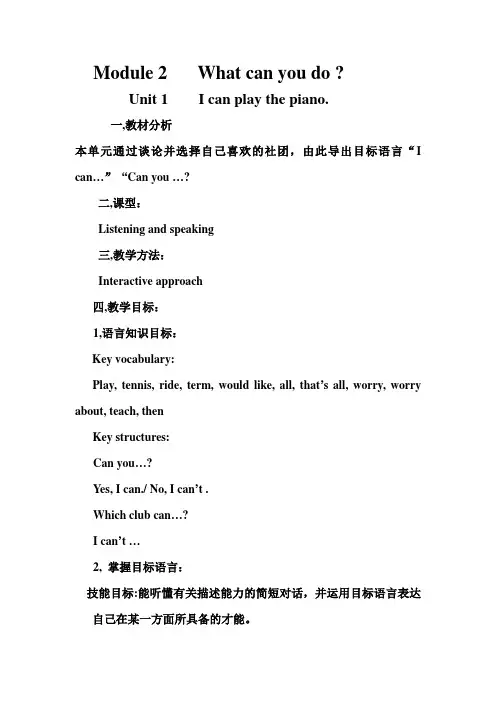
Module 2 What can you do ?
Unit 1 I can play the piano.
一,教材分析
本单元通过谈论并选择自己喜欢的社团,由此导出目标语言“I can…”“Can you …?
二,课型:
Listening and speaking
三,教学方法:
Interactive approach
四,教学目标:
1,语言知识目标:
Key vocabulary:
Play, tennis, ride, term, would like, all, that’s all, worry, worry about, teach, then
Key structures:
Can you…?
Yes, I can./ No, I can’t .
Which club can…?
I can’t …
2, 掌握目标语言:
技能目标:能听懂有关描述能力的简短对话,并运用目标语言表达自己在某一方面所具备的才能。
情感态度与价值观:帮助学生认识并肯定自己的能力,增强自信心,培养竞争意识和为班集体服务的意识。
学习策略:能根据自己的喜好和特长确定自己的发展目标
3,能力目标:
能根据自己的喜好和特长选择自己喜欢的俱乐部,并表达出自己在该俱乐部中可以做些什么。
五,教学反思
学生通过本课的学习,能顺利表述自己和他人在某一方面所具备的才能。
六,板书设计
Can you…?
Yes ,I can.
No , I can’t .
I can…, but I can’t…..。

Module 2 What can you do?Unit1 I can play the guitar. 教学设计一.Teaching AimsA.Language Knowledge:Key V ocabulary:play, tennis, ride, term, would like, all, that’s all, worry, worry about, teach, then,B.Speaking skill:To understand conversations about joining school clubs;To talk about one’s abilities.C.Listening skill:Improve the students’ listening ability.二.Teaching key points and difficulties:1.Teaching key points:Learn the new words and understand the using of “can” and “would like”. 2.Teaching difficulties:Understand and use the new words;develop the students’ability of using “can” and “would like”.三.Teaching Aids: Multi-Media (or Tape recorder, videos, OHP)四.Teaching Procedures:Step1 Warming-up1.Lead in with some pictures. (见课件中的图片)2.Let the students answer the questions and the teacher asks .【设计意图】:一是让学生复习语境中的新单词。
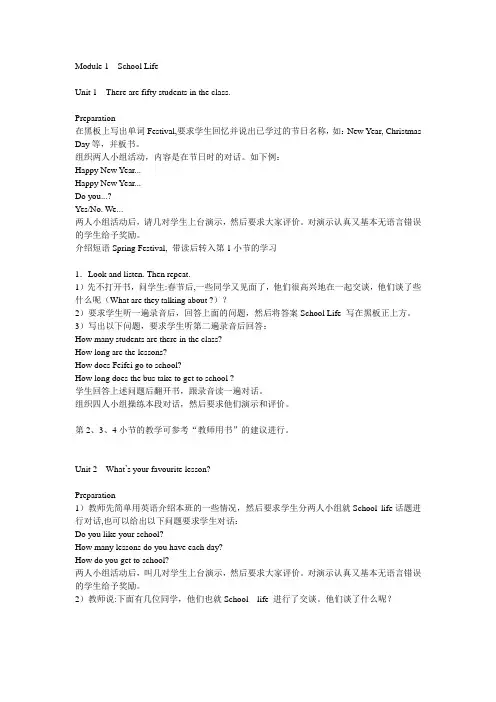
Module 1 School LifeUnit 1 There are fifty students in the class.Preparation在黑板上写出单词Festival,要求学生回忆并说出已学过的节日名称,如:New Year, Christmas Day等,并板书。
组织两人小组活动,内容是在节日时的对话。
如下例:Happy New Year...Happy New Year...Do you...?Yes/No. We...两人小组活动后,请几对学生上台演示,然后要求大家评价。
对演示认真又基本无语言错误的学生给予奖励。
介绍短语Spring Festival, 带读后转入第1小节的学习1.Look and listen. Then repeat.1)先不打开书,问学生:春节后,一些同学又见面了,他们很高兴地在一起交谈,他们谈了些什么呢(What are they talking about ?)?2)要求学生听一遍录音后,回答上面的问题,然后将答案School Life 写在黑板正上方。
3)写出以下问题,要求学生听第二遍录音后回答:How many students are there in the class?How long are the lessons?How does Feifei go to school?How long does the bus take to get to school ?学生回答上述问题后翻开书,跟录音读一遍对话。
组织四人小组操练本段对话,然后要求他们演示和评价。
第2、3、4小节的教学可参考“教师用书”的建议进行。
Unit 2 What’s your favourite lesson?Preparation1)教师先简单用英语介绍本班的一些情况,然后要求学生分两人小组就School life话题进行对话,也可以给出以下问题要求学生对话:Do you like your school?How many lessons do you have each day?How do you get to school?两人小组活动后,叫几对学生上台演示,然后要求大家评价。
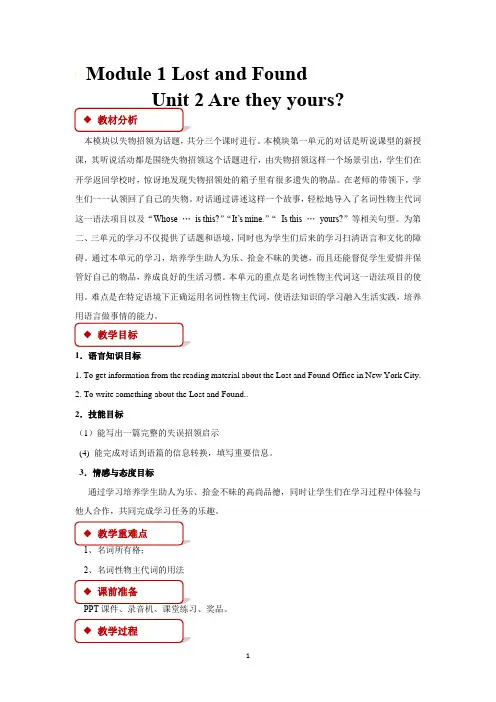
Module 1 Lost and Found Unit 2 Are they yours?本模块以失物招领为话题,共分三个课时进行。
本模块第一单元的对话是听说课型的新授课,其听说活动都是围绕失物招领这个话题进行,由失物招领这样一个场景引出,学生们在开学返回学校时,惊讶地发现失物招领处的箱子里有很多遗失的物品。
在老师的带领下,学生们一一认领回了自己的失物。
对话通过讲述这样一个故事,轻松地导入了名词性物主代词这一语法项目以及“Whose … is this?”“It’s mine.”“ Is this … yours?”等相关句型。
为第二、三单元的学习不仅提供了话题和语境,同时也为学生们后来的学习扫清语言和文化的障碍。
通过本单元的学习,培养学生助人为乐、拾金不昧的美德,而且还能督促学生爱惜并保管好自己的物品,养成良好的生活习惯。
本单元的重点是名词性物主代词这一语法项目的使用。
难点是在特定语境下正确运用名词性物主代词,使语法知识的学习融入生活实践,培养用语言做事情的能力。
1.语言知识目标1. To get information from the reading material about the Lost and Found Office in New York City.2. To write something about the Lost and Found..2.技能目标(1)能写出一篇完整的失误招领启示(4) 能完成对话到语篇的信息转换,填写重要信息。
3.情感与态度目标通过学习培养学生助人为乐、拾金不昧的高尚品德,同时让学生们在学习过程中体验与他人合作,共同完成学习任务的乐趣。
1、名词所有格;2、名词性物主代词的用法PPT 课件、录音机、课堂练习、奖品。
◆教学目标◆课前准备 ◆ ◆教学过程◆教材分析 ◆教学重难点Step 1 Warming-up1. Show some pictures to review the words of school things.2. Review the text of Unit 1.3. Read the words after the teacher.4. Introduce the new words.Step 2 Complete the sentences.1. Ask the students to read the words in the box in Activity 1.2. Look at pictures in Activity 1 carefully.3. Read through the sentences.A man is talking to a woman at the lost and found office. He’s looking for his ______.A man is getting on the bus. His ________ is lost.4. Complete the sentences with the correct words and expression from the box5. Ask the students to check with a partner.6. Check the answers:Keys: 1. camera 2. mobile phoneStep 3 Reading.1. Play the recording.2. Ask the students to read through the passage.3. Read the passage and answer the questions.1) When do people often lose things?2) Why are there lost and found offices at airports and stations?3) What do people do at the lost and found office?4) What strange things are there at the New York City Lost and Found Office?4. Check with a partner.5. Call back the answers from the whole class.Keys:1. People often lose things when they’re travelling or when they’re in a hurry.2. Because people leave things on planes, on trains, on buses and in taxis.3. They look for things they have lost.4. There are about a hundred bikes, a large boat, a lot of animals and some sausages.6. Read the text together.7. Learning to learn.Reading passages with interesting facts can help you understand and remember English. Try to find passages with facts to read.Step 4 Do exercises.1. Ask the students to the words in the box in Activity 3.2. Ask the students to read through the passage in Activity3.People in a hurry often (1)__________ things, and there are (2)__________ things at lost and found offices at (3)__________ and (4)__________. At the New York City Lost and Found Office, there are also some very (5)__________ things. There are fifteen kilos of (6)__________ —are they yours? And how do you lose a (7)__________ boat on a train?3. Complete the passage with the correct from of the words and expression from the box..4. Check with a partner.5. Call back the answers from the whole class.6. Read the passage together.Keys: 1. lose 2. hundreds of 3. airports 4. stations 5. strange 6. sausages 7. largeStep 5 Guessing game.1. Show some pictures.2. According to the information given and ask the students to guess what it is.3. Show the pictures to check the answers.Step 6 Writing.4. Read the lost and found notes. Write notes for two more things.2. Check with a partner.3. Call back the answers from the whole class.Step 7 Do exercises:Ⅰ.根据句意及汉语提示写出句中所缺单词。
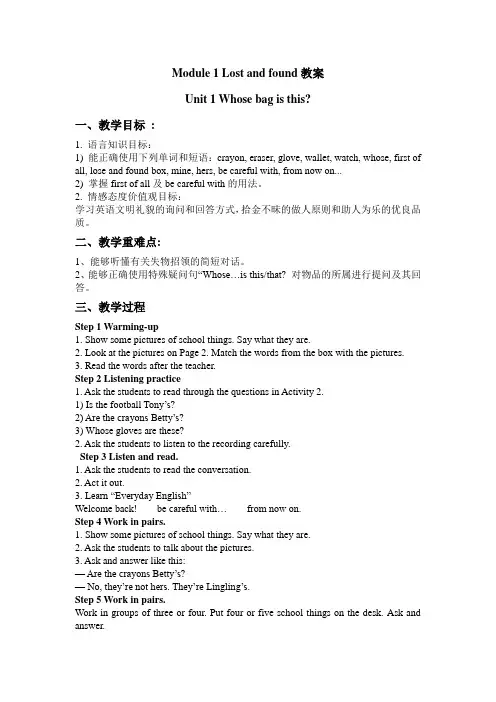
Module 1 Lost and found教案Unit 1 Whose bag is this?一、教学目标:1. 语言知识目标:1) 能正确使用下列单词和短语:crayon, eraser, glove, wallet, watch, whose, first of all, lose and found box, mine, hers, be careful with, from now on...2) 掌握first of all及be careful with的用法。
2. 情感态度价值观目标:学习英语文明礼貌的询问和回答方式,拾金不昧的做人原则和助人为乐的优良品质。
二、教学重难点:1、能够听懂有关失物招领的简短对话。
2、能够正确使用特殊疑问句“Whose…is this/that? 对物品的所属进行提问及其回答。
三、教学过程Step 1 Warming-up1. Show some pictures of school things. Say what they are.2. Look at the pictures on Page 2. Match the words from the box with the pictures.3. Read the words after the teacher.Step 2 Listening practice1. Ask the students to read through the questions in Activity2.1) Is the football Tony’s?2) Are the crayons Betty’s?3) Whose gloves are these?2. Ask the students to listen to the recording carefully.Step 3 Listen and read.1. Ask the students to read the conversation.2. Act it out.3. Learn “Everyday English”Welcome back! be careful with… from now on.Step 4 Work in pairs.1. Show some pictures of school things. Say what they are.2. Ask the students to talk about the pictures.3. Ask and answer like this:—Are the crayons Betty’s?—No, they’re not hers. They’re Lingling’s.Step 5 Work in pairs.Work in groups of three or four. Put four or five school things on the desk. Ask and answer.1. The students choose the school things. Ask and answer like this:A: Is this your pen?B: Yes, it’s mine.A: Whose pencil is it?C: It’s …2. Read through the example with the class.3. Pair them to ask and answer.Step 6 Language points1. First of all, come and look in the lost and found box!First of all 是在介绍准备讲的几件事情的第一件事情。
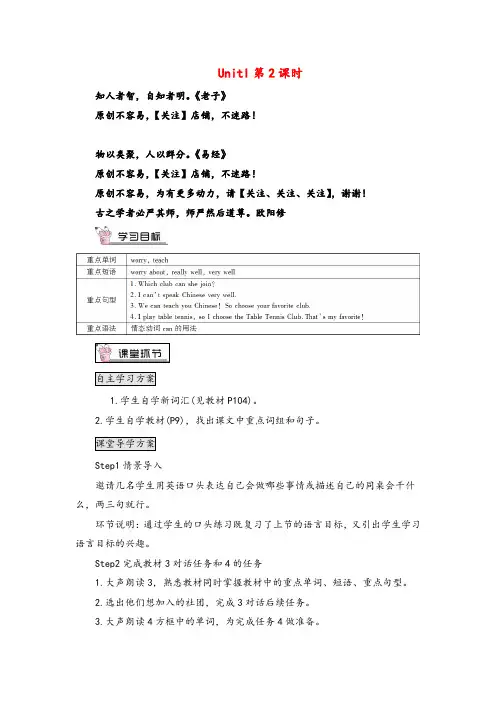
Unitl第2课时知人者智,自知者明。
《老子》原创不容易,【关注】店铺,不迷路!物以类聚,人以群分。
《易经》原创不容易,【关注】店铺,不迷路!原创不容易,为有更多动力,请【关注、关注、关注】,谢谢!古之学者必严其师,师严然后道尊。
欧阳修自主学习方案1.学生自学新词汇(见教材P104)。
2.学生自学教材(P9),找出课文中重点词组和句子。
课堂导学方案Step1情景导入邀请几名学生用英语口头表达自己会做哪些事情或描述自己的同桌会干什么,两三句就行。
环节说明:通过学生的口头练习既复习了上节的语言目标,又引出学生学习语言目标的兴趣。
Step2完成教材3对话任务和4的任务1.大声朗读3,熟悉教材同时掌握教材中的重点单词、短语、重点句型。
2.选出他们想加入的社团,完成3对话后续任务。
3.大声朗读4方框中的单词,为完成任务4做准备。
4.用方框里的单词的适当形式填空,完成任务4,集体核对答案。
5.大声读短文4,熟记重点句子。
6.小结训练。
把下列句子变成一般疑问句,并作肯定回答和否定回答。
(1)Icanswim.→Canyouswim?→Yes,Ican./No,Ican’t.SingspeakChinese?—Yes,hecan.—CanBettyplaytabletennis?—No,shecan’t.Step4问题探究well与good(1)well作副词,意为“好地”,常用来修饰动词。
放在动词之后。
此外well还可作形容词,意为“身体好的”。
如:Shecandncewell.她的舞蹈跳得好。
Shedidn’tfeelwell.她感觉不舒服.(2)good形容词,意为“好的”,常用来修饰名词。
如:Sheisagoodcooker.她是一个好厨师。
Step5家庭作业请完成模块2Unit1第2课时的练习题。
本课时通过突发情况的假设来引入课题,训练和学习相关内容的表达,把课堂内容与实际可能碰到的情况相结合,有很好的巩固强化作用。
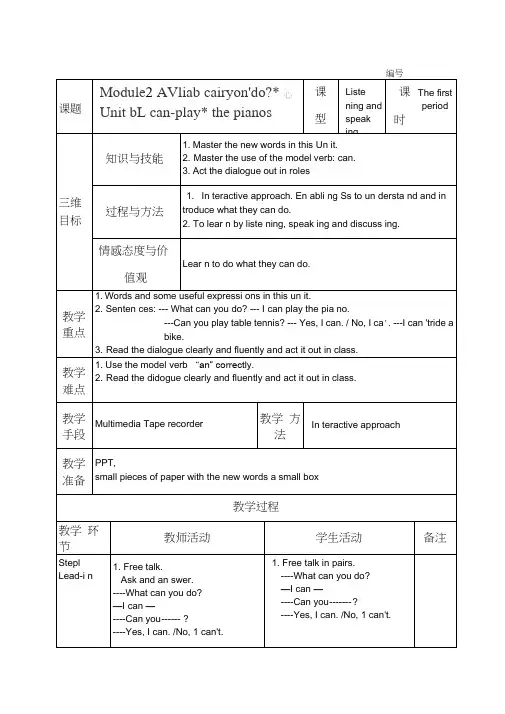
编号教学环节教师活动学生活动备注Step2 Prese ntati on 1. Words study.1) Get the Ss to pronounce thenew words in this un it.2) Use the sentence structure topractice the new words and someexpressi ons.1. Words study.1) Pronounce the new words inthis un it.2) Use the senten cestructure topractice the new words andsome expressi ons.3) . Match the words andexpressions from the box withthe pictures in Part1.i2. Liste ning practice.1) Listen and check the things inActivity1 which Tony ' dad can do.2) Check the an swers.2. Liste ning practice.1) Liste n and check the thi ngsin Activity1 which Tony's dadcan do.2) Check the an swers.3. Liste n and read.1) Play the tape and get the Ss toliste n to the dialogue in Part 3.2) Read and an swer the questi on.3) Read after the tape loudly.4) Check the an swers one by one.5) Get the students to finish Part4 inthe book. The n get a stude nt toread it in class.3. Liste n and read.1) Liste n to the dialogue in Part3.2) Read and an swer thequesti ons.3) Read after the tape loudly.4) Check the answers one byone.5) F i nish Part4 in the book.Then read it in class.4. Discuss and practice.1) Discuss in pairs about thedialogue and find out the problems.2) Solve the problems the Ss findout.3) Act out the dialogue in roles.4. Discuss and practice.1) Discuss in pairs about thedialogue and find out theproblems.2) Solve the problems with thepart ner.3) Act out the dialogue in roles.4) Some groups act in dass.5) Choose the winners in theperforma nee.Step3 Summary AndExte nsion1.Sum up what we learn in thisclass.2. Workin pairs in Part 7.Look at the information and askand an swer.Eg.---Can Daming speak Chin ese?——Yes, he can.---Can Betty play table tennis?----No, he can't.3. In terview the Ss what they cando in groups and report.1.Sum up what we lear n in thisclass.2.Workin pairs in Part 7.Look at the in formati on andask and an swer.板书设计Module2 What can you do? Un itl I can play the pia no.1. ----What ca n you do?—I can ________2. —Can you ________ ?----Yes, I ca n. / No, I ca n't.教学反思反复使用修订记录说明。
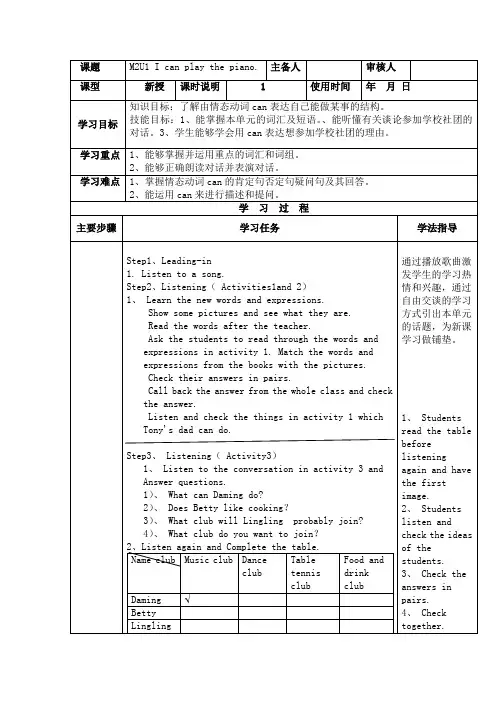

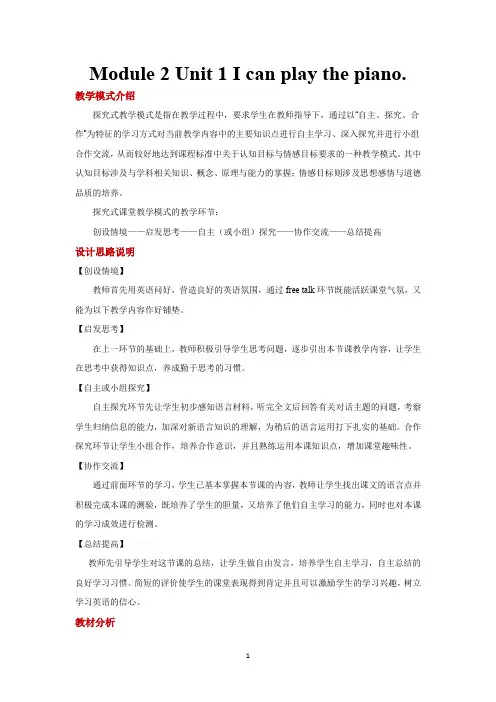
Module 2 Unit 1 I can play the piano. 教学模式介绍探究式教学模式是指在教学过程中,要求学生在教师指导下,通过以“自主、探究、合作”为特征的学习方式对当前教学内容中的主要知识点进行自主学习、深入探究并进行小组合作交流,从而较好地达到课程标准中关于认知目标与情感目标要求的一种教学模式。
其中认知目标涉及与学科相关知识、概念、原理与能力的掌握;情感目标则涉及思想感情与道德品质的培养。
探究式课堂教学模式的教学环节:创设情境——启发思考——自主(或小组)探究——协作交流——总结提高设计思路说明【创设情境】教师首先用英语问好,营造良好的英语氛围,通过free talk环节既能活跃课堂气氛,又能为以下教学内容作好铺垫。
【启发思考】在上一环节的基础上,教师积极引导学生思考问题,逐步引出本节课教学内容,让学生在思考中获得知识点,养成勤于思考的习惯。
【自主或小组探究】自主探究环节先让学生初步感知语言材料,听完全文后回答有关对话主题的问题,考察学生归纳信息的能力,加深对新语言知识的理解,为稍后的语言运用打下扎实的基础。
合作探究环节让学生小组合作,培养合作意识,并且熟练运用本课知识点,增加课堂趣味性。
【协作交流】通过前面环节的学习,学生已基本掌握本节课的内容,教师让学生找出课文的语言点并积极完成本课的测验,既培养了学生的胆量,又培养了他们自主学习的能力,同时也对本课的学习成效进行检测。
【总结提高】教师先引导学生对这节课的总结,让学生做自由发言,培养学生自主学习,自主总结的良好学习习惯。
简短的评价使学生的课堂表现得到肯定并且可以激励学生的学习兴趣,树立学习英语的信心。
教材分析本模块第一单元对话的内容是谈论并选择自己喜欢的社团,由此导出目标语言“I can...”“Can you ...?”等。
第二单元的话题“竞选班委”是中国学生熟悉的一个话题,课文形式是学生的班委竞选词,在教学中要保护学生的积极性,引导学生发现身边每个同学的闪光点。
外研版七年级英语Module2 Unit1电子教案Module 2 My familyUnit 1 Is this your mum? (Period 1)I、Teaching Aims:1、Knowledge aims:(1) Students master some new words about family members.(2) Students will master phrases-- on the left, on the right, next to, in front of.2、Ability aims:(1) The Ss will be able to get the specific information from the conversation.(2) Most students will be able to talk about family fluently and many students will be able to communicate with the sentence patterns “Is this/ Are these…? Who’s this?”3、Moral aims:Students will be able to love and respect their family.II、Teaching points:1、Key vocabulary:aunt、brother、sister、daughter、father、mother……2、Key structures:Is this/ Are these…?Who’s this?”III、Teaching difficulties:1、Listen the text and choose the correct answer.(1)Play the tape and have them read and follow the recording.(2)Ask the students to read through the conversation individually. Then choose the correct answer.2、Underline the correct words.3、Check the answersStep 4 Listening and reading1、To ask students to talk about Tony’s family.2、Invite some students to introduce their family.3、Check the answers by asking individual students.4、Listening again and try to answer two questions.5、Check together.6、Ask students to say out the key sentences and then the teacher explain them and writes down on the blackboard.Step 5 Summary and homework1、Give a brief summary of this lesson.2、Preview the left part of this unit.3、Talk your family with your partners.VII、Blackboard design:Module 2 My familyUnit 1 Is this your mum?New words: family, father, mother, daughter, son, left , right, woman …Key structures: Is this your…?Yes, …Are these…?Who’s this?”Questions: (1) What’s Tony’s sister’s name?(2)How many people are there in Tony’s family? X、Teaching reflection:。
Module2 Unit1 I can play the piano.第二课时教学设计【课标分析】(一)课标摘录听:1. 能听懂有关熟悉话题的语段;2.能识别不同句式的语调,如陈述句、疑问句和指令等。
说:1. 能在课堂活动中,用简短的英语进行交流;2.能在教师的指导下参与简单的游戏和角色扮演活动。
读:能理解并执行有关学习活动的简短书面指令。
(二)课标分解1.能听懂围绕有关于社团及自我情况的简短对话,并获取姓名、特长、社团名称等细节信息;2.能用含有情态动词can的陈述句简单介绍自己的情况,也能通过疑问句与别人交流个人信息,组织对话。
【教材分析】本模块第一单元对话的内容是谈论并选择自己喜欢的社团,由此导出目标语言“I can…” “Can you…?”等。
对话通过几个好朋友根据自己的能力和爱好谈论要参加哪个社团这样一个很自然的语境,呈现出了本模块的语法项目“can”的肯定句、否定句和疑问句形式。
本单元的口语的口语输出活动要求学生根据自己的爱好选择自己喜欢的社团,并表达出版已有该社团可以做什么。
创设真实的语境,让学生发挥想象力,能真实、全面地表达自己的思想,抒发他们的情感,把语言知识变成真正的语言能力。
【学情分析】知识基础:在初一上学期阶段,学生已经掌握了简单的介绍自己能做什么的表达方式,所以学生理解起来比较简单。
生活经验:学生在日常生活中,面对老师或家人,经常回答类似的问题,所以学生对“特长”的话题并不陌生。
学习方式:学生经过一个学期的学习,已经熟悉周围的同学以及老师的教学模式,所以在两两合作和小组合作方面可以很好的运用。
【学习目标】1.通过表格填空和对话讨论,在语境中正确应用play, tennis, piano, ride, club, term, board, well all, worry, teach等词汇。
2.通过自主探究发现疑问,小组讨论合作解决简单的问题,在语境中理解并掌握would like, that’s all, worry about等的用法。
Module 2 What can you do?模块分析本模块“询问和谈论彼此能力”这一话题很好地迎合了此时此刻学生们希望进一步增强了解和彰显个性的心理需求,学习内容和学生们的生活可谓息息相关。
本模块第一单元对话的内容是谈论并选择自己喜欢的社团(俱乐部),由此导出目标语言“I can ...”“Can you ...?”等。
对话通过几个好朋友根据自己的能力和爱好谈论要参加哪个社团这样一个很自然的语境,呈现出了本模块的语法项目:can的肯定句、否定句和疑问句形式。
本模块第二单元的话题“竞选班委”是中国学生非常熟悉的一个话题。
课文形式是学生的班委竞选词,每个人写出自己要参选的职务和自己的优势,号召大家选自己。
通过第一单元的学习,学生们对彼此的能力和爱好有了深入的了解,现在学习了竞选班委的课文之后,学生们应该可以根据实际情况,运用目标语言仿写出相似的文段来。
本模块的第一课时是听说课,重点在于训练学生如何谈论并选择自己喜欢的社团。
Period 1 Unit 1 I can play the piano (1-4)教学目标【知识目标】1. 词汇:play, tennis, piano, ride, club, term, board, would like, well, that’s all, worry, worry about,teach, then2. 句型:(1) —Can you …? —Yes, I can ... / No, I can’t …(2) —Which club can you join? —I can join … club.【技能目标】1. 学生能够听懂关于参加学校社团等的对话;2. 能够交流各自会干什么与不会干什么。
【情感态度】培养学生认识自我和肯定自我的能力,增强自信心以及助人为乐的精神。
【文化意识】了解不同国家的语言差异。
【学习策略】通过交流彼此的特长与爱好培养团队意识。